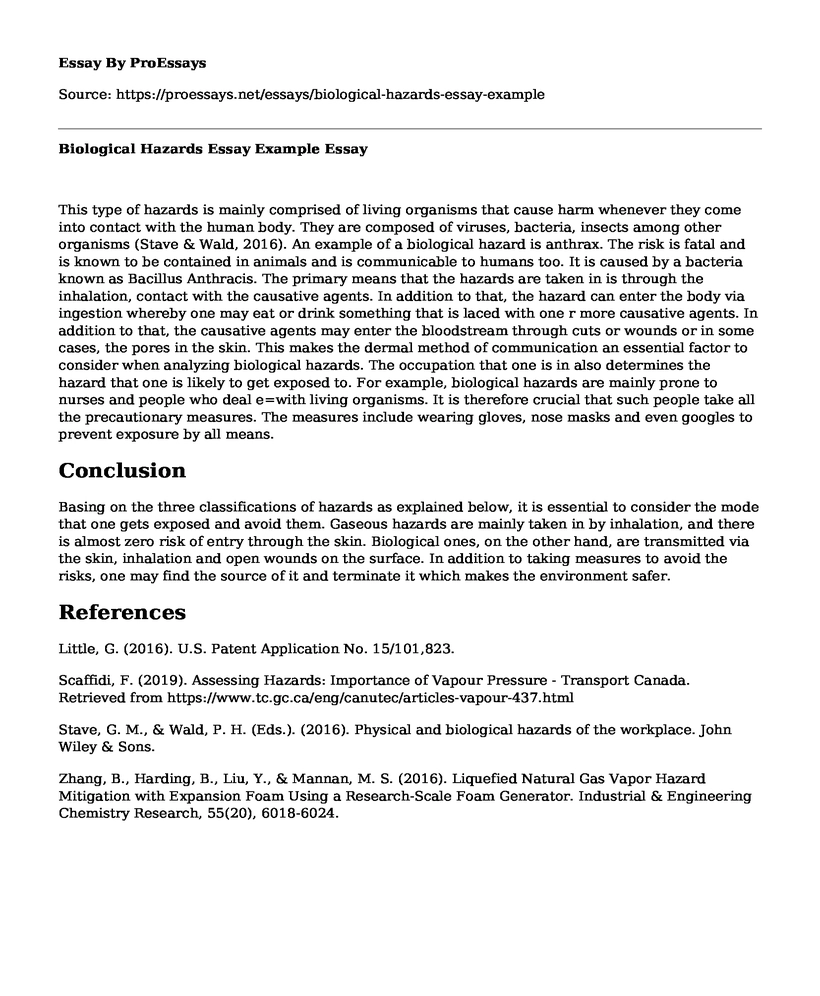This type of hazards is mainly comprised of living organisms that cause harm whenever they come into contact with the human body. They are composed of viruses, bacteria, insects among other organisms (Stave & Wald, 2016). An example of a biological hazard is anthrax. The risk is fatal and is known to be contained in animals and is communicable to humans too. It is caused by a bacteria known as Bacillus Anthracis. The primary means that the hazards are taken in is through the inhalation, contact with the causative agents. In addition to that, the hazard can enter the body via ingestion whereby one may eat or drink something that is laced with one r more causative agents. In addition to that, the causative agents may enter the bloodstream through cuts or wounds or in some cases, the pores in the skin. This makes the dermal method of communication an essential factor to consider when analyzing biological hazards. The occupation that one is in also determines the hazard that one is likely to get exposed to. For example, biological hazards are mainly prone to nurses and people who deal e=with living organisms. It is therefore crucial that such people take all the precautionary measures. The measures include wearing gloves, nose masks and even googles to prevent exposure by all means.
Conclusion
Basing on the three classifications of hazards as explained below, it is essential to consider the mode that one gets exposed and avoid them. Gaseous hazards are mainly taken in by inhalation, and there is almost zero risk of entry through the skin. Biological ones, on the other hand, are transmitted via the skin, inhalation and open wounds on the surface. In addition to taking measures to avoid the risks, one may find the source of it and terminate it which makes the environment safer.
References
Little, G. (2016). U.S. Patent Application No. 15/101,823.
Scaffidi, F. (2019). Assessing Hazards: Importance of Vapour Pressure - Transport Canada. Retrieved from https://www.tc.gc.ca/eng/canutec/articles-vapour-437.html
Stave, G. M., & Wald, P. H. (Eds.). (2016). Physical and biological hazards of the workplace. John Wiley & Sons.
Zhang, B., Harding, B., Liu, Y., & Mannan, M. S. (2016). Liquefied Natural Gas Vapor Hazard Mitigation with Expansion Foam Using a Research-Scale Foam Generator. Industrial & Engineering Chemistry Research, 55(20), 6018-6024.
Cite this page
Biological Hazards Essay Example. (2022, Nov 20). Retrieved from https://proessays.net/essays/biological-hazards-essay-example
If you are the original author of this essay and no longer wish to have it published on the ProEssays website, please click below to request its removal:
- Emergency Management: WMD Case Study
- Reflections on Nursing Practice Essay
- Essay Sample on Maxime Fitness Company
- Essay Sample on Sporting Risk Management Decisions
- Paper Example on Leiomyoma in Pregnancy: Impact of IVF
- Unpacking Community Health Education Theory: Promoting Health Equity - Research Paper
- Essay Sample on Nola Pender's HPM: External and Internal Cues for Nurse Practitioners







